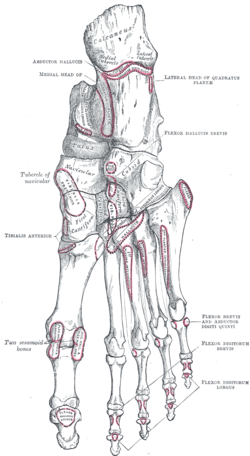| Interphalangeal joints of foot | |
|---|---|
 The MTP, IP, PIP, and DIP joints of the foot:
| |
 Bones of the foot. Interphalangeal joints highlighted (orange background area) | |
| Details | |
| Identifiers | |
| Latin | articulationes interphalangeae pedis |
| MeSH | D014033 |
| TA98 | A03.6.10.901 |
| TA2 | 1968 |
| FMA | 35225 71357, 35225 |
| Anatomical terminology | |
The interphalangeal joints of the foot are the joints between the phalanx bones of the toes in the feet.
Contents
Since the great toe only has two phalanx bones (proximal and distal phalanges), it only has one interphalangeal joint, which is often abbreviated as the "IP joint". The rest of the toes each have three phalanx bones (proximal, middle, and distal phalanges), so they have two interphalangeal joints: the proximal interphalangeal joint between the proximal and middle phalanges (abbreviated "PIP joint") and the distal interphalangeal joint between the middle and distal phalanges (abbreviated "DIP joint").
All interphalangeal joints are ginglymoid (hinge) joints, and each has a plantar (underside) and two collateral ligaments. In the arrangement of these ligaments, extensor tendons supply the places of dorsal ligaments, which is similar to that in the metatarsophalangeal articulations.
Toe bones or phalanges of the foot. Note the big toe has no middle phalanx.
People vary; sometimes the smallest toe also has none (not shown). [1]


